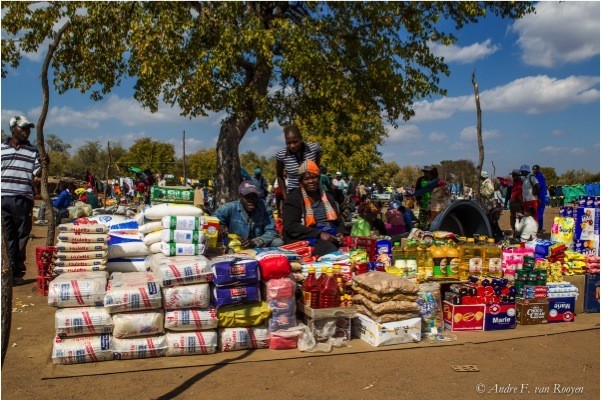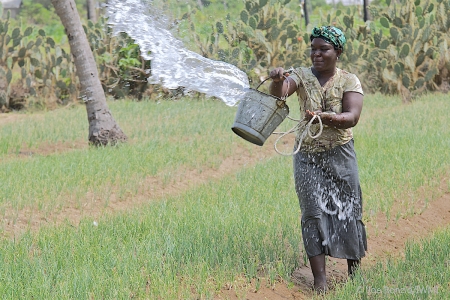Widespread consensus exists that the use of research is very important for achieving development goals. But what’s the best strategy for ensuring that research results make it beyond the journal article and into the real world?
 Farmers 'buy food security' with income from livestock sales. Photo: Andre F. van Rooyen
Farmers 'buy food security' with income from livestock sales. Photo: Andre F. van RooyenResearch for development was the main principle governing the CGIAR Challenge Program on Water and Food (CPWF). One theory of change the program tested was to bring research findings into the hands of development professionals on the assumption that these change agents would be able to adopt, adapt, and scale up innovations. This assumption was tested particularly under a two-year grant from IFAD, which was recently brought to a close with an event at IFAD headquarters in Rome.
At the event, researchers who contributed to CPWF presented a number of tools and approaches that have potential to foster development impact at scale and that therefore are assumed to be of interest to IFAD decision makers and field staff. One such approach is the use of innovation platforms (PDF), which the International Crops Research Institute for the Semi-Arid Tropics (ICRISAT) has used to strengthen the livelihoods of farmers in semi-arid Zimbabwe who grow crops and raise livestock in combination.
A market-oriented development approach
Using ICRISAT’s integrated market-oriented development approach, the research team has facilitated improved value chains for goats—improving both the supply of seeds and other necessary materials and establishing new markets for farmers to sell their goats—thereby generating both the incentives for farmers to invest in their production and the much-needed cash for them to do so. Farmers who participate in goat markets are reinvesting income generated into broader agriculture production. They are now able to purchase crops when their own harvest falls short, pay for education and health care, hire labor, and purchase inputs for both crops and livestock. These reinvestment patterns clearly illustrate that development of more sustainable and resilient crop-livestock systems is feasible.
Imagining that initiatives such as ICRISAT’s work in Zimbabwe could attract interest and support from development institutions such as IFAD is easy enough. By garnering support from larger and more powerful actors, such innovative approaches could be allowed to bloom and scale up, and the link between research and development would be established.
Conditions for conducive partnership?
Yet, to continuously replicate this effect and ensure wider uptake of research innovations, CGIAR would be required to further formalize its collaborative relationships with development institutions such as IFAD. To this end, a new way to perceive partnerships between CGIAR and IFAD was presented and discussed during the recent event in Rome. Based on the experiences of the CGIAR Research Program on Water, Land and Ecosystems (WLE), which has collaborated with IFAD in Lao PDR during the past year, a new strategy for linking research and development was proposed: Partnerships should be designed at the country and investment portfolio level from the start, allowing WLE and CGIAR to provide a sort of context-specific advisory service to IFAD.
But this approach also comes with its own set of challenges: Researchers could potentially resist to “just act as consultants”, the institutional frameworks and cultures on both sides might be insufficiently conducive for partnerships, and inflexible contracting procedures make partnering challenging.
What do you think: What would be the best way for CGIAR to collaborate with development institutions such as IFAD? Would such collaborations be a good way to ensure that research does contribute to development? Let us know in the comments!
More information:
Goat Production and Marketing in Zimbabwe a presentation by Andre van Rooyen
Where Research Meets Development an interview with IFAD's Audrey Nepveu and CPWF's Alain Vidal






/index.jpg?itok=EzuBHOXY&c=feafd7f5ab7d60c363652d23929d0aee)









Comments
Thanks Marianne for this brief report of a very nice event to "close" this IFAD Grant work and pass the bâton to WLE.
I see a huge potential for IFAD and its programming to benefit from a better understanding of and engagement with CGIAR research-for-development in general, since IFAD and CGIAR share a lot of their values and objectives, and IFAD, unlike other lending or granting development agencies, still has a broad set of in-house technical skills. But instead of an ad hoc mechanism where CGIAR researchers or programs are brought on board a bit like consultants, we could probably try to develop a mechanism where the CGIAR pool of expertise could be brought in more systematically, especially in countries where both institutions are focusing their efforts. I think this is what this IFAD grant has also tried to explore, but there is still a long way to go. But we can't say "no" to such an opportunity !
CPWF has in many instances and with many partners enabled a shift in mindsets and behaviours in the way R4D is considered and implemented. By supporting mainstreaming of CPWF innovations, IFAD also intended to make this happen in its development interventions, among others through its Country Portfolio Managers. The "old model" where countries were not ready to use loans to finance and develop R4D is actually out-of-date now in most countries (past in the 90's e.g. Pakistan and Tunisia were already dedicating 2% of their World Bank loans on irrigation and drainage projects to R4D).
Therefore a shift in mindsets and behaviours could be to have IFAD Country Portfolio Managers think more (if not always) of a R4D component in the country actions they formulate. This could be supported by mobilizing the pool of expertise provided by CGIAR, among others through secondments of CGIAR Programs' staff to IFAD (as presently CCAFS and A4NH do).
I would like to add to Alain's comment, with which I agree in principle. I have worked a lot at the "interface" of IFAD and the CGIAR (through IWMI as directly with IFAD). I think that moving to an effective partnership that really promotes innovation and scaling up innovative ideas would require quite drastic changes in the culture and incentive systems of both institutions. Both share basic values and goals as Alain notes; but the CGIAR is not yet at a point where large-scale application of research results is seen as high priority investment; and IFAD is overly focused on committing and spending the funds allocated for each country. It has a flawed process of project development and implementation which I documented in a report a few years ago. This is compounded by over-burdened and under-resources country program managers who are not necessarily rewarded for innovation as a high priority. I think the two institutions would need to engage in depth to find a way to partner effectively over a longer term, and both sides would need to be willing to be self-critical and make real changes in how they do their complementary businesses.